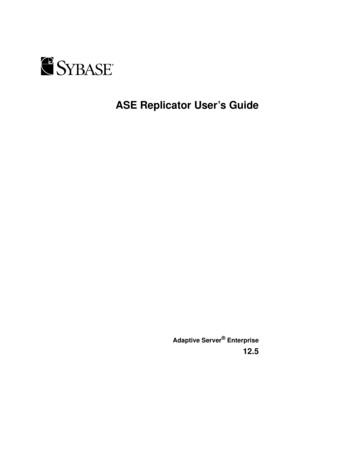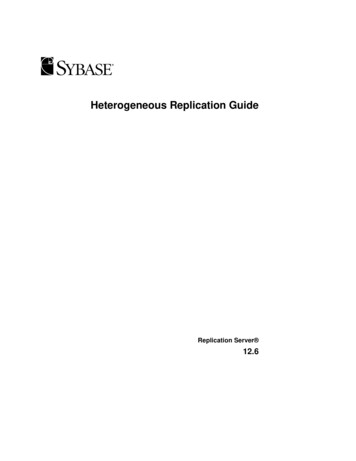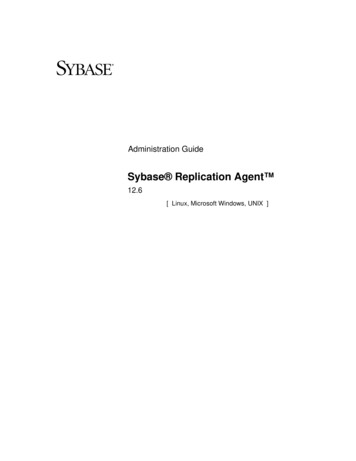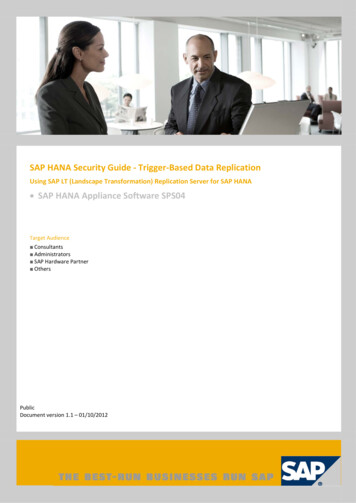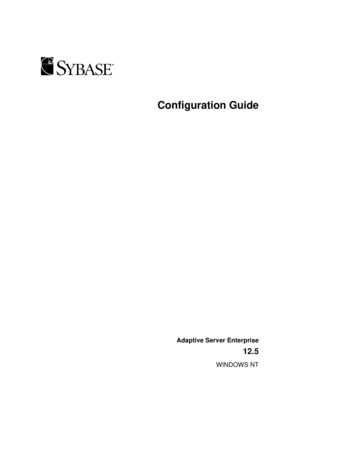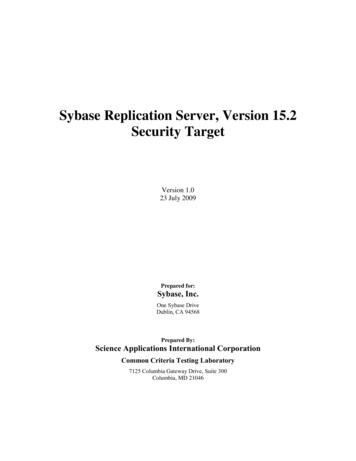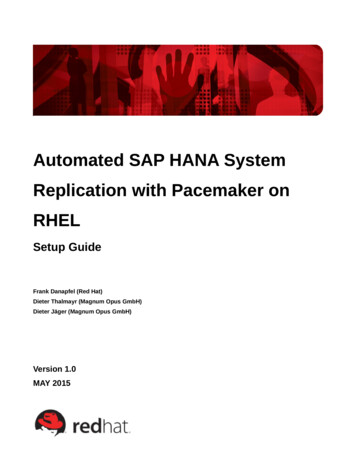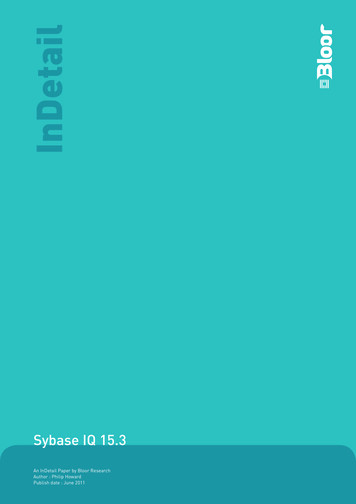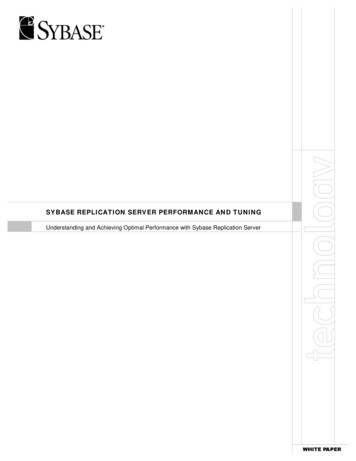
Transcription
Overview GuideSybase Replication Server Options12.6[ Linux, Microsoft Windows, and UNIX ]
DOCUMENT ID: DC32753-01-1260-01LAST REVISED: October 2005Copyright 2001-2005 by Sybase, Inc. All rights reserved.This publication pertains to Sybase software and to any subsequent release until otherwise indicated in new editions or technical notes.Information in this document is subject to change without notice. The software described herein is furnished under a license agreement,and it may be used or copied only in accordance with the terms of that agreement.To order additional documents, U.S. and Canadian customers should call Customer Fulfillment at (800) 685-8225, fax (617) 229-9845.Customers in other countries with a U.S. license agreement may contact Customer Fulfillment via the above fax number. All otherinternational customers should contact their Sybase subsidiary or local distributor. Upgrades are provided only at regularly scheduledsoftware release dates. No part of this publication may be reproduced, transmitted, or translated in any form or by any means, electronic,mechanical, manual, optical, or otherwise, without the prior written permission of Sybase, Inc.Sybase, the Sybase logo, ADA Workbench, Adaptable Windowing Environment, Adaptive Component Architecture, Adaptive Server,Adaptive Server Anywhere, Adaptive Server Enterprise, Adaptive Server Enterprise Monitor, Adaptive Server Enterprise Replication,Adaptive Server Everywhere, Adaptive Warehouse, Afaria, Answers Anywhere, Anywhere Studio, Application Manager, AppModeler,APT Workbench, APT-Build, APT-Edit, APT-Execute, APT-Translator, APT-Library, AvantGo Mobile Delivery, AvantGo MobileInspection, AvantGo Mobile Marketing Channel, AvantGo Mobile Pharma, AvantGo Mobile Sales, AvantGo Pylon, AvantGo PylonApplication Server, AvantGo Pylon Conduit, AvantGo Pylon PIM Server, AvantGo Pylon Pro, Backup Server, BizTracker,ClearConnect, Client-Library, Client Services, Convoy/DM, Copernicus, Data Pipeline, Data Workbench, DataArchitect, DatabaseAnalyzer, DataExpress, DataServer, DataWindow, DataWindow .NET, DB-Library, dbQueue, Developers Workbench, DirectConnect,DirectConnect Anywhere, Distribution Director, e-ADK, E-Anywhere, e-Biz Impact, e-Biz Integrator, E-Whatever, EC Gateway,ECMAP, ECRTP, eFulfillment Accelerator, Embedded SQL, EMS, Enterprise Application Studio, Enterprise Client/Server, EnterpriseConnect, Enterprise Data Studio, Enterprise Manager, Enterprise SQL Server Manager, Enterprise Work Architecture, Enterprise WorkDesigner, Enterprise Work Modeler, eProcurement Accelerator, EWA, Financial Fusion, Financial Fusion Server, Gateway Manager,GlobalFIX, iAnywhere, iAnywhere Solutions, ImpactNow, Industry Warehouse Studio, InfoMaker, Information Anywhere, InformationEverywhere, InformationConnect, InternetBuilder, iScript, Jaguar CTS, jConnect for JDBC, M2M Anywhere, Mach Desktop, MailAnywhere Studio, Mainframe Connect, Maintenance Express, Manage Anywhere Studio, M-Business Channel, M-Business Network,M-Business Server, MDI Access Server, MDI Database Gateway, media.splash, MetaWorks, mFolio, Mirror Activator, MySupport, NetGateway, Net-Library, New Era of Networks, ObjectConnect, ObjectCycle, OmniConnect, OmniSQL Access Module, OmniSQLToolkit, Open Biz, Open Client, Open ClientConnect, Open Client/Server, Open Client/Server Interfaces, Open Gateway, Open Server,Open ServerConnect, Open Solutions, Optima , PB-Gen, PC APT Execute, PC DB-Net, PC Net Library, PocketBuilder, PocketPowerBuilder, Power , power.stop, PowerAMC, PowerBuilder, PowerBuilder Foundation Class Library, PowerDesigner,PowerDimensions, PowerDynamo, PowerScript, PowerSite, PowerSocket, Powersoft, PowerStage, PowerStudio, PowerTips, PowersoftPortfolio, Powersoft Professional, PowerWare Desktop, PowerWare Enterprise, ProcessAnalyst, QAnywhere, Rapport, RemoteWare,RepConnector, Replication Agent, Replication Driver, Replication Server, Replication Server Manager, Replication Toolkit, ReportExecute, Report Workbench, Resource Manager, RFID Anywhere, RW-DisplayLib, RW-Library, S-Designor, SDF, Search Anywhere,Secure SQL Server, Secure SQL Toolset, Security Guardian, SKILS, smart.partners, smart.parts, smart.script, SOA Anywhere, SQLAdvantage, SQL Anywhere, SQL Anywhere Studio, SQL Code Checker, SQL Debug, SQL Edit, SQL Edit/TPU, SQL Everywhere, SQLModeler, SQL Remote, SQL Server, SQL Server Manager, SQL SMART, SQL Toolset, SQL Server/CFT, SQL Server/DBM, SQLServer SNMP SubAgent, SQL Station, SQLJ, STEP, SupportNow, S.W.I.F.T. Message Format Libraries, Sybase Central, Sybase Client/Server Interfaces, Sybase Financial Server, Sybase Gateways, Sybase IQ, Sybase MPP, Sybase SQL Desktop, Sybase SQL Lifecycle,Sybase SQL Workgroup, Sybase User Workbench, SybaseWare, Syber Financial, SyberAssist, SybFlex, SyBooks, System 10, System11, System XI (logo), SystemTools, Tabular Data Stream, TradeForce, Transact-SQL, Translation Toolkit, UltraLite, UltraLite.NET,UNIBOM, Unilib, Uninull, Unisep, Unistring, URK Runtime Kit for UniCode, VisualWriter, VQL, WarehouseArchitect, WarehouseControl Center, Warehouse Studio, Warehouse WORKS, Watcom, Watcom SQL, Watcom SQL Server, Web Deployment Kit, Web.PB,Web.SQL, WebSights, WebViewer, WorkGroup SQL Server, XA-Library, XA-Server, XcelleNet, and XP Server are trademarks ofSybase, Inc. 06/05Unicode and the Unicode Logo are registered trademarks of Unicode, Inc.All other company and product names used herein may be trademarks or registered trademarks of their respective companies.Use, duplication, or disclosure by the government is subject to the restrictions set forth in subparagraph (c)(1)(ii) of DFARS 52.227-7013for the DOD and as set forth in FAR 52.227-19(a)-(d) for civilian agencies.Sybase, Inc., One Sybase Drive, Dublin, CA 94568.
ContentsAbout This Book . vCHAPTER 1CHAPTER 2Introducing Replication Server Options .What are the Replication Server Options? .Descriptions of option components .Sybase Replication Agent .Enterprise Connect Data Access .Adaptive Server Enterprise .Description of Sybase Central.Description of Replication Server .11335666Replication Server Options Sample Solutions. 9Consolidating data into a central repository . 9Distributing enterprise data between multiple central databases . 11iii
Contentsiv
About This BookAudienceThis book is intended for those using components in addition toReplication Server for replication to or from Adaptive Server Enterprise (ASE) and an Oracle, Informix, Microsoft, or IBM database.Product name changesBefore Enterprise Connect Data Access 12.5, its options were sold asindividual DirectConnect products named “DirectConnect for [target].”Other than in the installer, you will see the name “DirectConnect” used inthe software and in documents. Old and current option names are asfollows:Table 1: DirectConnect and ECDA namingOld product nameDirectConnect for DB2 UDBCurrent option nameEnterprise Connect Data Access Option forDB2 UDBDirectConnect for InformixEnterprise Connect Data Access Option forInformixDirectConnect for MicrosoftSQL ServerDirectConnect for OracleEnterprise Connect Data Access Option forMicrosoft SQL ServerEnterprise Connect Data Access Option forOracleHow to use this bookSeeChapter 1, “IntroducingReplication ServerOptions”Chapter 2, “ReplicationServer Options SampleSolutions”ForDescription of the option components andrelated productsSample solutions using the options andReplication ServerRelated documentsSee your product documentation for detailed descriptions of how to installand use Replication Server and the Replication Server Optionscomponents.Other sources ofinformationUse the Sybase Getting Started CD, the SyBooks CD, and the SybaseProduct Manuals Web site to learn more about your product:Overview Guidev
The Getting Started CD contains release bulletins and installation guidesin PDF format, and may also contain other documents or updatedinformation not included on the SyBooks CD. It is included with yoursoftware. To read or print documents on the Getting Started CD, you needAdobe Acrobat Reader, which you can download at no charge from theAdobe Web site using a link provided on the CD. The SyBooks CD contains product manuals and is included with yoursoftware. The Eclipse-based SyBooks browser allows you to access themanuals in an easy-to-use, HTML-based format.Some documentation may be provided in PDF format, which you canaccess through the PDF directory on the SyBooks CD. To read or print thePDF files, you need Adobe Acrobat Reader.Refer to the SyBooks Installation Guide on the Getting Started CD, or theREADME.txt file on the SyBooks CD for instructions on installing andstarting SyBooks. The Sybase Product Manuals Web site is an online version of the SyBooksCD that you can access using a standard Web browser. In addition toproduct manuals, you will find links to EBFs/Maintenance, TechnicalDocuments, Case Management, Solved Cases, newsgroups, and theSybase Developer Network.To access the Sybase Product Manuals Web site, go to Product Manuals athttp://www.sybase.com/support/manuals/.Sybase certificationson the WebTechnical documentation at the Sybase Web site is updated frequently. viTo find the latest information on product certifications1Point your Web browser to Technical Documents athttp://www.sybase.com/support/techdocs/.2Click Certification Report.3In the Certification Report filter select a product, platform, and timeframeand then click Go.4Click a Certification Report title to display the report.To find the latest information on component certifications1Point your Web browser to Availability and Certification Reports athttp://certification.sybase.com/.2Either select the product family and product under Search by BaseProduct; or select the platform and product under Search by Platform.Replication Server Options
About This Book3 Select Search to display the availability and certification report for theselection.To create a personalized view of the Sybase Web site (including supportpages)Set up a MySybase profile. MySybase is a free service that allows you to createa personalized view of Sybase Web pages.1Point your Web browser to Technical Documents athttp://www.sybase.com/support/techdocs/.2Click MySybase and create a MySybase profile.Sybase EBFs andsoftwaremaintenance To find the latest information on EBFs and software maintenance1Point your Web browser to the Sybase Support Page athttp://www.sybase.com/support.2Select EBFs/Maintenance. If prompted, enter your MySybase user nameand password.3Select a product.4Specify a time frame and click Go. A list of EBF/Maintenance releases isdisplayed.Padlock icons indicate that you do not have download authorization forcertain EBF/Maintenance releases because you are not registered as aTechnical Support Contact. If you have not registered, but have validinformation provided by your Sybase representative or through yoursupport contract, click Edit Roles to add the “Technical Support Contact”role to your MySybase profile.5ConventionsIllustrations in this book use icons to represent these components of a dataenterprise system: Overview GuideClick the Info icon to display the EBF/Maintenance report, or click theproduct description to download the software.Adaptive Server Enterprise and other data serversvii
This icon represents either an Adaptive Server Enterprise (ASE) or a nonSybase data server. If the data server in an example must be ASE, the dataserver icon is labeled “ASE.” Replication ServerThis icon represents Replication Server, the Sybase application thatmaintains replicated data on a local area network (LAN) and processesdata transactions received from other Replication Servers on the wide areanetwork (WAN). Replication Server Manager ClientThis icon represents Replication Server Manager (RSM) Client, thegraphical user interface (GUI) portion of the Replication Server plug-infor Sybase Central. Replication Server Manager ServerThis icon represents Replication Server Manager (RSM) Server, theserver portion of the Replication Server plug-in for Sybase Central. Replication AgentThis icon represents a Replication Agent , a replication system processthat transfers transaction information from a database to a ReplicationServer for distribution to other databases.Every database from which you replicate data requires a replication agentspecific to the database. Adaptive Server has its own replication agentthread called RepAgent. Replication agents for all other data servers areseparate processes, and this icon represents a replication agent that is aseparate process.viiiReplication Server Options
About This Book DirectConnectThis icon represents a DirectConnect data access server. DirectConnectservers connect LAN-based clients and heterogeneous data servers. TheReplication Server options contain DirectConnect servers for MicrosoftSQL Server, Oracle, Informix, and DB2 Universal Database. ASE/CISThis icon represents Adaptive Server Enterprise/Component IntegrationServices (ASE/CIS). When combined with the appropriate DirectConnectserver, ASE/CIS provides transparent read/write access to databasesystems such as DB2 Universal Database for UNIX and for MicrosoftWindows, Informix, and Oracle. Client applicationsThis icon represents a client application, which is a user process orapplication connected to a data server. It can be a front-end applicationprogram executed by a user or a program that executes as an extension ofthe system.AccessibilityfeaturesOverview GuideThis document is available in an HTML version that is specialized foraccessibility. You can navigate the HTML with an adaptive technology (suchas a screen reader) or view it with a screen enlarger.ix
Replication Server Options version 12.6 and the HTML documentation havebeen tested for compliance with U.S. government Section 508 Accessibilityrequirements. Documents that comply with Section 508 generally also meetnon-U.S. accessibility guidelines, such as the World Wide Web Consortium(W3C) guidelines for Web sites.Note You might need to configure your accessibility tool for optimal use.Some screen readers pronounce text based on its case; for example, theypronounce ALL UPPERCASE TEXT as initials, and MixedCase Text aswords. You might find it helpful to configure your tool to announce syntaxconventions. Consult the documentation for your tool.For information about how Sybase supports accessibility, see SybaseAccessibility at http://www.sybase.com/accessibility. The Sybase Accessibilitysite includes links to information on Section 508 and W3C standards.For a Section 508 compliance statement for Replication Server Options version12.6, see Sybase Accessibility at http://www.sybase.com/detail?id 1028493.If you need helpxEach Sybase installation that has purchased a support contract has one or moredesignated people who are authorized to contact Sybase Technical Support. Ifyou cannot resolve a problem using the manuals or online help, please have thedesignated person contact Sybase Technical Support or the Sybase subsidiaryin your area.Replication Server Options
CH A PTE R1Introducing Replication ServerOptionsThis chapter introduces the Replication Server Options.TopicWhat are the Replication Server Options?Descriptions of option componentsPage13Description of Sybase CentralDescription of Replication Server66Note Before ECDA 12.5, its options were sold as individualDirectConnect products named “DirectConnect for [target].” Other thanin the installer, you will see the name “DirectConnect” used in thesoftware and in documents, including this document.What are the Replication Server Options?The Replication Server Options are available separately from ReplicationServer. Therefore, you must have the Replication Server Options inaddition to Replication Server to implement the solutions described in thisdocument.The Replication Server Options can be used with Replication Server forbidirectional replication across distributed, heterogeneous systems toenable different operational and decision-support tasks.The four Replication Server Options contain the replication componentsnecessary for replication with one of the following databases:Overview Guide DB2 Universal Database (on UNIX and Microsoft Windowsplatforms) Informix Dynamic Server1
What are the Replication Server Options? Microsoft SQL Server OracleNote These replication components can be used to implement bidirectionalreplication on the Microsoft Windows and UNIX platforms. To implement abidirectional replication solution for DB2 UDB for OS/390 or a unidirectionalsolution for AS/400, you must have Replication Agent for DB2 for MVS andDirectConnect for DB2 UDB for AS/400, respectively. These products are soldseparately from the Replication Server Options.The set of components necessary for bidirectional replication consists of aReplication Agent for the primary database platform, a DirectConnect for thereplicate database platform, and an ASE.Figure 1-1 illustrates the Replication Server Option components available.Figure 1-1: Components of the four Replication Server OptionsReplication Server Option for IBM DB2UDB (UNIX and NT)Replication Agentfor IBM DB2 UDB(UNIX and NT)2ASEDirectConnectfor DB2 UDBReplication Server Option for InformixReplication Agentfor InformixASEDirectConnectfor InformixReplication Server Option for MicrosoftSQL ServerReplication Server Option for OracleReplication Agent ASEfor Microsoft SQLServerReplication Agentfor OracleDirectConnectfor MicrosoftSQL ServerASEDirectConnectfor OracleReplication Server Options
CHAPTER 1Introducing Replication Server OptionsThe ASE included with a Replication Server Option is used for storing theReplication Server System Database (RSSD).Note Replication for DB2 in OS/390 is performed by Replication Agent forDB2 for MVS, which is not included in the Replication Server Options. Forinformation on Replication Agent for DB2 for MVS, refer to thedocumentation for that product.With Replication Server and one or more Replication Server Options, you canperform the following tasks: Manage your replication system and Sybase components using the SybaseCentral GUI Replicate data across heterogeneous environments using numerousdatabases (DB2 UDB, Informix, Microsoft SQL Server, and Oracle),allowing data to be shared among different operational and decisionsupport systems without affecting business performance Integrate disparate business systems, including legacy data, into acoordinated, easily accessed, and powerful corporate business enterpriseDescriptions of option componentsThis section describes each of the following components of Replication ServerOptions: Sybase Replication Agent Enterprise Connect Data Access Adaptive Server EnterpriseFor special instructions on installing option components, refer to theReplication Server Options Release Bulletin.Sybase Replication AgentSybase Replication Agent captures transactions in the primary database andthen transfers them to Replication Server for distribution to replicate databases.Overview Guide3
Descriptions of option componentsSybase Replication Agent extends the capabilities of Replication Server byallowing non-Sybase database servers to be primary data servers in a Sybasereplication system.Replication Agent reads the primary database transaction log and generatesLog Transfer Language (LTL). Replication Server uses LTL to process anddistribute replicated transactions through a replication system.Sybase ReplicationAgent configurationsEach Replication Server option contains the Replication Agent suitable for aparticular platform: Sybase Replication Agent for UDB – retrieves transactions from a DB2Universal Database primary database on UNIX and Microsoft Windowsplatforms. Sybase Replication Agent for Informix – retrieves transactions from anInformix primary database. Sybase Replication Agent for Microsoft SQL Server – retrievestransactions from a Microsoft SQL Server primary database. Sybase Replication Agent for Oracle – retrieves transactions from anOracle primary database.In addition to the four main components, Replication Agent has anadministration port that provides an administrative user interface.StandaloneapplicationSybase Replication Agent runs as a standalone application, independent of theprimary database server, the primary Replication Server, and other componentsof a replication system.Sybase Replication Agent can reside on the same host machine as any othercomponent of the replication system, or it can reside on a machine that isseparate from other replication system components.Sybase ReplicationAgent managementSybase Replication Agent instances can be configured, managed, andmonitored by Replication Server Manager (RSM). In addition, you cancompletely configure, manage, and monitor a Sybase Replication Agentinstance using any Open Client application (such as isql) that is capable ofcommunicating with the Sybase Tabular Data Stream (TDS) protocol.For more information on Replication Agent, see the documentation specific tothat product.4Replication Server Options
CHAPTER 1Introducing Replication Server OptionsEnterprise Connect Data AccessEnterprise Connect Data Access (ECDA) is an integrated set of softwareapplications and connectivity tools that you use to access data within aheterogeneous database environment. ECDA gives you the ability to access avariety of LAN-based, non-Sybase data sources, as well as mainframe datasources. It consists of components that provide transparent data access withinan enterprise.ECDA components allow applications to interact with non-Sybase DBMSs,such as DB2 UDB, Informix, Microsoft SQL Server, and Oracle, as well asSybase DBMSs, including Adaptive Server and Sybase IQ.DirectConnectDirectConnect is the ECDA component that provides basic connectivity tonon-Sybase data sources. In particular, it provides access management,transaction management, and remote systems management throughDirectConnect Manager.DirectConnect consists of a server and one or more access service libraries,which have specific sets of configuration properties. The server provides theframework in which the service libraries operate. Each access service libraryaccesses data from a particular target database, such as DB2 UDB, Informix,Microsoft SQL Server, and Oracle.DirectConnect serversDirectConnectManagerECDA includes these DirectConnect servers: DirectConnect for DB2 UDB, which provides connectivity to DB2 UDBrunning on z/OS, AS400, NT, and UNIX platforms DirectConnect for Informix, which provides connectivity to Informixdatabase servers DirectConnect for Microsoft SQL Server, which provides connectivity toMicrosoft SQL Server databases DirectConnect for Oracle, which provides connectivity to Oracle databaseserversYou can use the DirectConnect plug-in for Sybase Central, calledDirectConnect Manager, to configure, manage, and control your data accessenvironment. To learn how to use Sybase Central to manage DirectConnect,see the DirectConnect Manager online help.For more information on DirectConnect, see the documentation specific to thatproduct.Overview Guide5
Description of Sybase CentralAdaptive Server EnterpriseAdaptive Server Enterprise (ASE) is the relational database server in theSybase client-server architecture used in mission-critical, transaction-intensiveenterprise environments.The ASE distributed with DirectConnect is used for storing the RSSD.For more information about ASE, see What's New in Sybase Adaptive ServerEnterprise?.Adaptive Server plugin to Sybase CentralThe Adaptive Server plug-in for Sybase Central allows you to manage theinstallation and administration of ASE using the Sybase Central graphicalmanagement tool. To learn how to use Sybase Central to manage ASE, see theAdaptive Server plug-in online help.Description of Sybase CentralSybase Central is a graphical tool that provides a common interface formanaging Sybase products. Each server product is managed by a serviceprovider “plug-in” that operates in parallel with other service providers in theSybase Central framework. Sybase Central runs on Microsoft Windows.Sybase Central displays a visual representation of servers and provides a pointand-click interface for choosing options. Plug-ins use Sybase Central JavaEdition, a Java-based viewer.In addition to the base product and options, the following server plug-ins areprovided: Adaptive Server Enterprise plug-in – lets you manage and monitor allAdaptive Server installations. DirectConnect Manager – lets you manage DirectConnect serversthroughout your business environment.Description of Replication ServerThe Replication Server Options are available separately from ReplicationServer. You must already have Replication Server to obtain the ReplicationServer Options and to implement the functionality described in this chapter.6Replication Server Options
CHAPTER 1Introducing Replication Server OptionsThe Replication Server product consists of the following components: Replication Server Replication Server Manager (RSM)Figure 1-2 shows the components distributed with the Replication Serverproduct.Figure 1-2: Components in the Replication Server base productReplicationServerRSMFor details on these components, see the Replication Server AdministrationGuide and the Replication Server Heterogeneous Replication Guide.Overview Guide7
Description of Replication Server8Replication Server Options
CH A PTE R2Replication Server OptionsSample SolutionsThis chapter provides examples of how the Replication Server Optionscan be used with Replication Server to implement solutions.TopicConsolidating data into a central repositoryDistributing enterprise data between multiple central databasesPage911Consolidating data into a central repositoryProfileA telecommunications company has satellite offices in San Francisco andChicago that use Microsoft SQL Server to store local customerinformation. Headquarters in Boston uses ASE to store company-widecustomer information. Replication Agent captures the changes inMicrosoft SQL Server at the satellite offices and passes them toReplication Server. Replication Server applies data changes to theheadquarters’ consolidated customer database, which is stored in ASE.Sybase componentsTo set up unidirectional consolidation into a central repository, thetelecommunications company uses the following components: Sybase Replication Server ASE RSM Sybase Replication Agent for Microsoft SQL ServerSee Chapter 1, “Introducing Replication Server Options,” fordescriptions of specific components.FigureOverview GuideFigure 2-1 illustrates this sample scenario.9
Consolidating data into a central repositoryFigure 2-1: Unidirectional consolidation into a central repositoryRSMClientRSMServerSan FranciscoMicrosoft SQLServer1SybaseSybaseSybaseReplication ReplicationServer 1AgentReplicationServer 2SybaseReplicationAgentChicagoMicrosoft SQLServer 2SybaseReplicationServer 3BostonASE10Replication Server Options
CHAPTER 2Replication Server Options Sample SolutionsDistributing enterprise data between multiple centraldatabasesProfileA large regional supplier maintains its enterprise data in a central database inSacramento before merging with a second regional supplier of comparable sizein Denver. The Sacramento enterprise maintains its data on an Oracle system,while the Denver enterprise uses ASE. To circumvent the lengthy andexpensive process of migrating data to another platform, both organizationsimplement an integrative, bidirectional replication system.Sybase componentsTo set up bidirectional, enterprise-wide replication, the Sacramento enterpriseuses the following components:Figure Sybase Replication Server ASE Sybase Replication Agent for Oracle Sybase DirectConnect for OracleFigure 2-2 illustrates the sample scenario that integrates Oracle data with ASEdata.Figure 2-2: Bidirectional, enterprise-wide forOracleOverview Guide11
Distributing enterprise data between multiple central databases12Replication Server Options
This icon represents Replication Server, the Sybase application that maintains replicated data on a local area network (LAN) and processes data transactions received from other Replication Servers on the wide area network (WAN). Replication Server Manager Client This icon represents Replication Server Manager (RSM) Client, the
